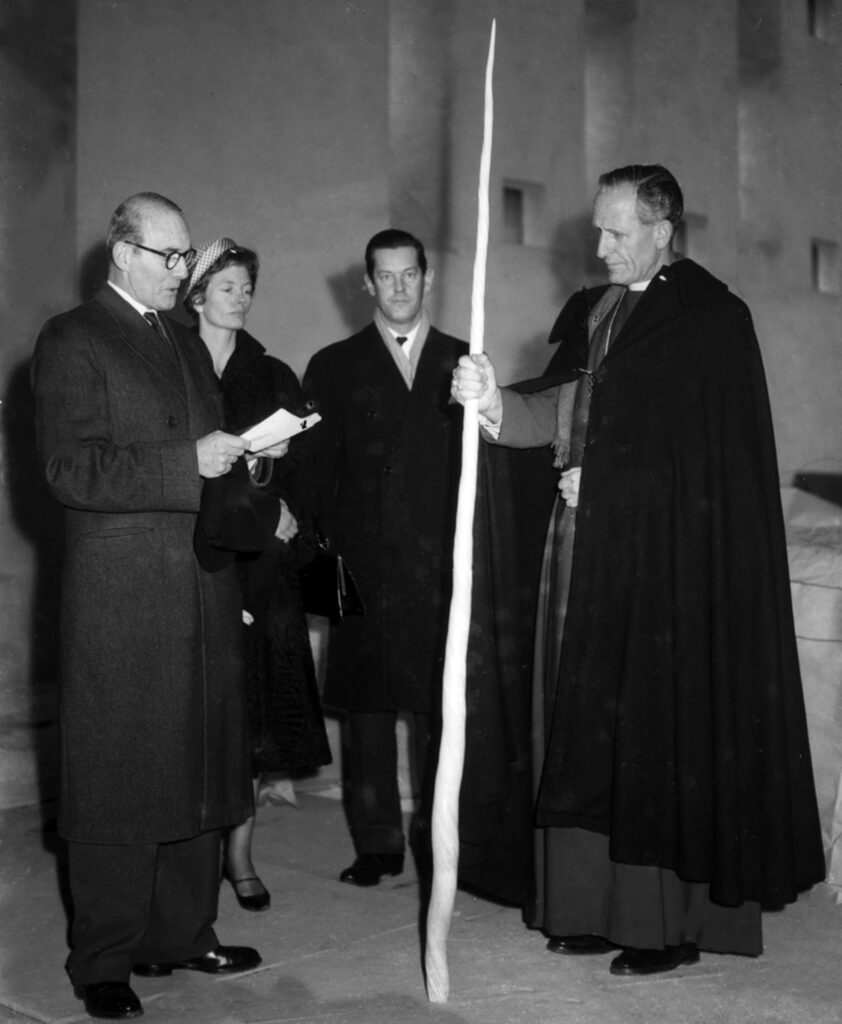
CovSoc member and Chair of the Friends of Coventry Cathedral, Martin Williams, reflects on the use of narwhal horn in public and religious life. Martin writes……
Did you see last month’s announcement that amongst the people awarded the Queen’s Gallantry Medal (the last list approved by Queen Elizabeth) were four of the people who fought the London Bridge terrorist in 2019? Amongst the weapons used against the terrorist was a narwhal horn.
That set me thinking, as narwhal horns are not often seen, but Coventry Cathedral has a narwhal horn of its own on display in St Michael’s Hall. It is incorporated into the Bishop’s crozier – the staff that the Bishop uses when he attends services in the Cathedral.
In the London Bridge incident the narwhal horn was used against the terrorist by Steve Gallant, one of the people now honoured. Mr Gallant was on his first day out of prison, on day release while serving a 17-year sentence, to take part in a Learning Together event at Fishmongers’ Hall, next to London Bridge.
He confronted the terrorist who was armed with two knives with a fake bomb strapped to his body. Gallant took the Fishmongers’ Hall narwhal horn from the man next to him and hit the terrorist with the horn which then snapped. The terrorist was shot by the police. In August 2021, Steve was released early from prison after being given a Royal Prerogative of Mercy in recognition of his heroic actions on London Bridge.

The story behind Coventry Cathedral’s narwhal horn came to light some years ago in a letter to The Independent. Ove Arup was head of the structural engineers responsible for the construction of Coventry Cathedral. Ruth Winawer, Ove Arup’s secretary, wrote to the paper:
…. one evening in the middle of work, Ove said: ‘Oh, by the way, Basil Spence is designing the official clothes for the Bishop of Coventry, and he wants a narwhal horn for the crozier – he seemed to think I could get him one because I was Danish – I don’t know why. See what you can do . . .’. He then went on with other work.
I telephoned the Cultural Attache at the Danish Embassy, and gave him the story, with special reference to Sir Basil Spence and Ove Arup (a favourite at the Embassy), and explained how much they would value his help in this important search. The Attache took it in his stride. He took charge from there, and obtained the object.
The Narwhal is a species of whale and its horn is a tooth that grows through the top of the skull. The horn is mainly a male feature, so scientists think its use is to establish dominance amongst the males during the mating season. (Mine is bigger than yours!) The horns are the only teeth Narwhals possess, so they are no use for feeding. The horns do have sensory nerve endings on the outside that can sense changes in the salinity of the water.
There are legends galore surrounding the narwhal. In the middle ages the narwhal horn was believed to derive from a unicorn, and to have magical healing properties. A narwhal tusk exhibited at Warwick Castle is supposedly the rib of the mythical Dun Cow that roamed the fields of Warwickshire. During the 16th century, Queen Elizabeth I received a carved and bejewelled narwhal horn worth £10,000 —the 16th-century equivalent cost of a castle (approximately £3 million).
And Coventry is not the only Cathedral with a narwhal horn. Chester Cathedral has in its treasury a 16th century carved narwhal horn covered with holy figures that include St Michael striking down the Devil with his Cross.
The Coventry Cathedral narwhal horn was the gift of the Danish Ministry of Eccesiastical Affairs to the church. In December 1961 it was presented to Bishop Cuthbert Bardsley (below right) by the Danish Ambassador, Mr Nils Svenningsen (left) in the presence of Mr Albert Koenigsfeldt, Counsellor at the Embassy , and Mrs Koenigsfeldt.
“We Danes are for ever indebted to the British people for the sacrifices and the perseverance symbolised in the name of Coventry.”
After the presentation when he felt the weight of the narwhal horn, the Bishop joked that in future he would have to have it carried in front of him by his chaplain. With the future consecration ceremony in mind he commented, “I think I could break the door down with this!”.

This article first appeared in the Chair’s newsletter from the Friends of the Coventry Cathedral, dated 31/3/2023 and is reprinted here with the kind permission of the Chair.
